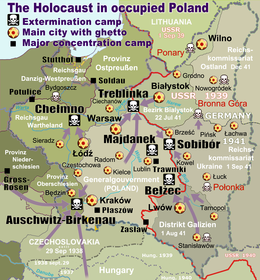Lvov Ghetto
| Lwów Ghetto | |
|---|---|

|
|
| Also known as | German: Ghetto Lemberg |
| Location |
Lwów, Zamarstynów (Poland) |
| Date | November 8, 1941 to June 1943 |
| Incident type | Imprisonment, mass shootings, forced labor, starvation, exile, forced abortions and sterilization |
| Organizations | Nazi SS |
| Camp | Bełżec, Janowska |
| Victims | 120,000 Polish Jews |
| Survivors | 823 |
The Lwów Ghetto (German: Ghetto Lemberg; Polish: getto we Lwowie) was a World War II Jewish ghetto established and operated by Nazi Germany in the city of Lwów (since 1945 Lviv, Ukraine) in the territory of Nazi-administered General Government in German-occupied Poland.
The Lwów Ghetto was one of the largest Jewish ghettos established by Nazi Germany after the joint Nazi-Soviet invasion of Poland. The city was a home to over 110,000 Jews before the outbreak of World War II in 1939, and by the time the Nazis occupied the city in 1941 that number had increased to over 220,000 Jews, since Jews fled for their lives from Nazi-occupied western Poland into the then relative safety of Soviet-occupied eastern Poland, which included Lwów. The ghetto, set up in the second half of 1941 after the Germans arrived, was liquidated in June 1943 with all its inhabitants who survived prior killings, sent to their deaths in cattle trucks at Bełżec extermination camp and the Janowska concentration camp.
On the eve of World War II, the city of Lwów had the third-largest Jewish population in Poland, after Warsaw and Łódź, 99,600 in 1931 (32%) by confession criteria (percent of people of Jewish faith) and numbering 75,300 (24%) by language criteria (percent of people speaking Yiddish or Hebrew as their mother tongue), according to Polish official census. Assimilated Jews, those who perceived themselves as Poles of Jewish faith, constitute the discrepancy between those numbers. By 1939, those numbers were, respectively, several thousand greater. Jews were notably involved in the city's renowned textile industry and had established a thriving center of education and culture, with a wide range of religious and secular political activity including parties and youth movements of the orthodox and Hasidim, Zionists, the Labour Bund, and communists. Assimilated Jews constituted a significant part of Lwów's Polish intelligentsia and academical elites, including such notable ones as Marian Auerbach, Maurycy Allerhand and many others, and greatly contributed to Lwów's cultural center status.
...
Wikipedia

